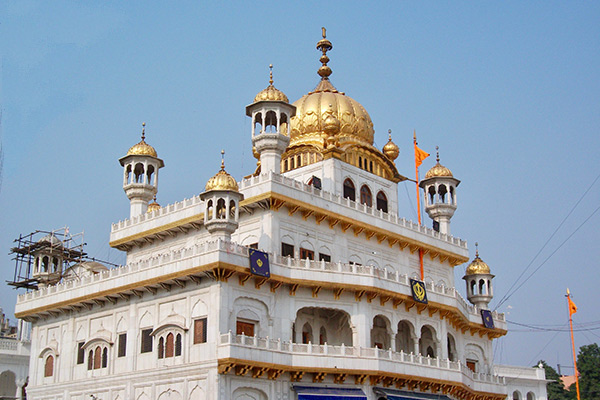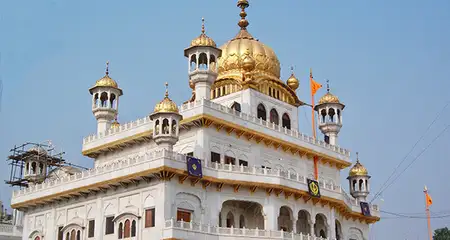The Akal Takht is the first and the most important of the five Takhts or seats of religious power in Sikhism. It is the highest site of authority that addresses the spiritual and temporal concerns of the Sikh community. Established in 1606, it served as a symbol of political resistance against the Mughals during the 17th and 18th centuries. The Akal Takht has also undergone various attacks in the course of history, including the controversial Indian military action named Operation Blue Star. Today, it serves as one of the most important religious sites and tourist attractions in Amritsar. Located in the same complex as the famous Golden Temple aka Harmandir Sahib, this intricately designed white structure offers a splendid sight.
Want to include this religious site in your Amritsar itinerary? Here’s everything you need to know about the Akal Takht, including its history, architecture, entry fee, attractions, timings, lesser-known facts, and other details.
Akal Takht, Amritsar Information
| Location | Harmandir Sahib Complex, Golden Temple Road |
| Type | Religious site |
| Also Known as | Akal Bunga |
| Timings | 2:30 am to 10:00 pm; every day |
| Entry Fee | No entry fee |
| Architectural Style | Sikh architecture |
| Status | First Takht of the Sikhs |
| Year of Establishment | 1606 |
| Rebuilt in | 1995 |
| Special Note | Visitors entering the complex are expected to dress appropriately, remove their shoes, and cover the head using a scarf. |
Akal Takht, Amritsar: History
Did you know that the magnificent Akal Takht that we see today isn’t the original structure? The original building, which was called Akal Bunga, was constructed in 1609 by Guru Hargobind, the sixth Sikh Guru, at the same site where it stands today. Back then, it was a simple platform measuring 3.5 meters in height, where the guru would hold court and listen to the petitioners. As a mark of his spiritual and temporal authority, he put two swords on the platform. Later, a semi-circular structure with gilded interior and marble pillars was constructed.
During the 18th century, the Akal Takht and the Golden Temple came under repeated attacks from Ahmed Shah Abdali, the famous Afghani emperor and Massa Rangar, a Mughal commander. Between 1770 and 1780, the structure was reconstructed using bricks. Hari Singh Nalwa, one of the generals under Maharaja Ranjit Singh, adorned the dome of the Akal Takht with gold.
During the infamous Operation Blue Star by the Indian Army in 1984, the Akal Takht suffered extensive damage. It was rebuilt by the Government of India but the Sikhs did not accept the new structure. Finally, they demolished it and rebuilt the Akal Takht in its present form in 1995.
Akal Takht, Amritsar: Architecture
The Akal Takht is part of the cluster of religious buildings located in the Golden Temple or Harmandir Sahib Complex. Standing right opposite the Golden Temple, which is the principal house of worship for the Sikhs, the present-day Akal Takht features five stories. The white structure has a dome plated with gold. It is located in an open courtyard, just beyond the large gateway at the main entrance.
Constructed in the Sikh style of architecture, the edifice features marble inlays, gilded interiors, and exquisitely painted wall panels. You can also find some traces of the old building, such as lime plaster painted with Mughal floral motifs. The unique structure of the Akal Takht has often been compared to that of the Piazza San Marco in Venice.
Akal Takht, Amritsar: Today
Today, the Akal Takht is a popular attraction for tourists and a pilgrimage spot for the Sikhs. It is also one of the top historical places to visit in Amritsar. The Guru Granth Sahib, the religious scripture of Sikhism, is kept on its first floor. Every morning, the holy book is carried out of the building to the sanctum of the Harmandir Sahib in an ornate palanquin. This ceremony is known as Prakash or the Opening Ritual. Every evening, in a ceremony called Sukhasan or the Closing Ritual, the book is taken back to the Akal Takht and put into a bed. Devotees throng at the building every morning and evening to witness these ceremonies.
Things to See in the Akal Takht and the Harmandir Sahib Complex
A visit to the Akal Takht can be an exciting experience in itself, thanks to its location in the Golden Temple complex that is home to several other attractions. Among the things to see in and around the structure are:
- A unique collection of weapons that once belonged to the Sikh gurus and warriors. Every evening, these weapons are exhibited on a golden palanquin inside the building
- The famous Golden Temple or Harmandir Sahib
- The Central Sikh Museum where you can see a rich collection of coins, paintings of Sikh saints, gurus and warriors, old manuscripts and ancient arms
- Ramgarhia Bunga (red stone watchtowers) where the royal seat is kept
- Dukh Bhanjani Beri Tree, an old jujube tree that bears religious significance
- A clock tower that dates back to the British era
- Guru Ram Das Langar, a community kitchen that provides free food all through the days for everyone visiting the complex
- Darshani Deori, the elaborate entrance gate leading to the Golden Temple
- Amrit Sarovar, the holy tank around the temple
- Gurdwara Thara Sahib, a small gurudwara located about 40 meters north of the Akal Takht
- Teja Singh Samundri Hall, the administrative building that houses the office of the temple management
- Gurudwara Baba Atal Sahib, another famous gurudwara located near the Golden Temple Complex
Lesser-known Facts about Akal Takht
- The word Akal means The Timeless One while Takhat/Takht is the Persian word for Throne – when put together, the words mean the Throne of the Timeless One.
- The edifice was built slightly lower in height than the Golden Temple. It signifies the order of importance in Sikhism.
- The height of the original Akal Takht was raised to 12 feet in order to defy the Mughal Emperor Jahangir who had issued an order prohibiting anyone else from sitting on a raised platform more than 3 feet in height.
- Of the five Sikh Takhts, only three are in Punjab (Akal Takht, Keshgarh Sahib, and Damdama Sahib). The other two – Patna Sahib and Hazur Sahib – are in Bihar and Maharashtra, respectively.
Attractions near Akal Takht
- Jallianwala Bagh (400 m)
- Guru Bazaar (500 m)
- Jama Masjid Khairuddin (1 km)
- Durgiana Temple (1.5 km)
- Lahori Gate Market (1.5 km)
- Hall Bazaar (2 km)
- Gobindgarh Fort (2 km)
- Mata Lal Devi Temple (3 km)
- Maharaja Ranjit Singh Museum (4 km)
A visit to Amritsar can never be complete without getting a taste of its lip-smacking cuisine. Since the Akal Takht is located in an area dotted with many of the top eateries and restaurants in Amritsar, you can end your visit with a hearty meal.




























